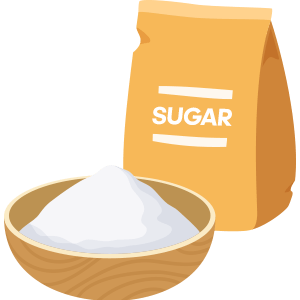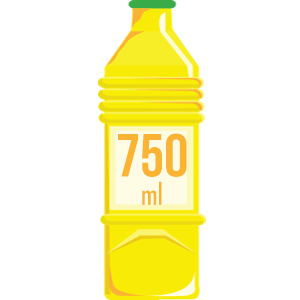When the inflation rate hit nine-year highs in 2018 , it made banner headlines across the Philippines.
No question about it: anything that potentially has a huge impact on people’s cost of living deserves media attention.
In fact, inflation ranks among 2018’s biggest stories, accounting for 7.7% of all business and political articles out of the country, according to an analysis that data insights company TheNerve has done as of December using its natural language processing tool.
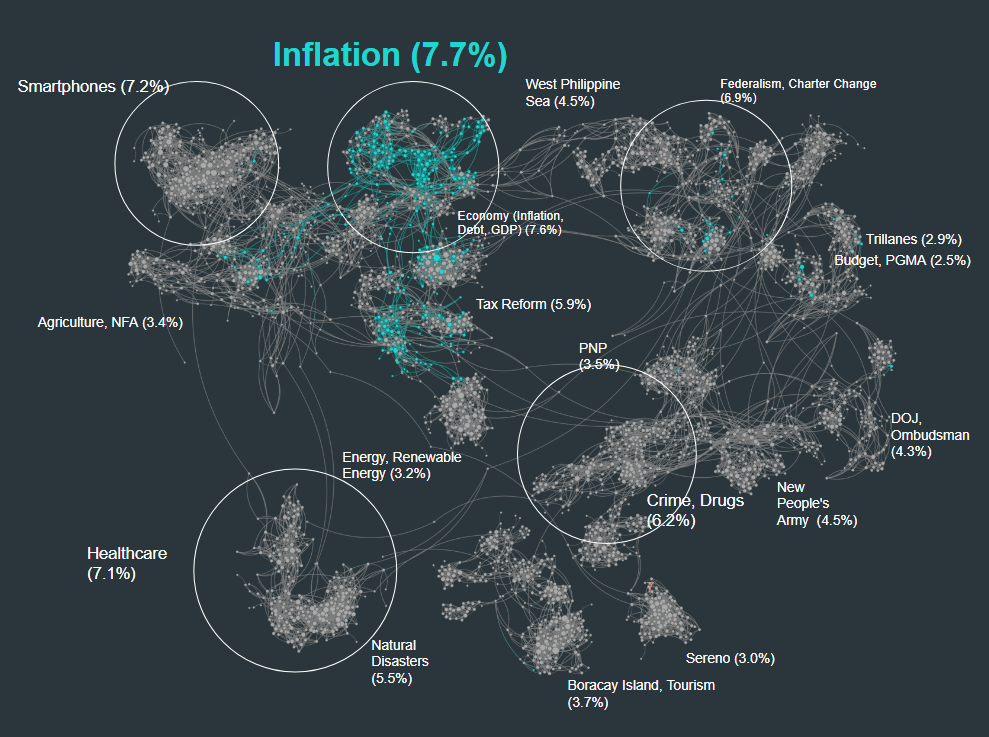
"Inflation" mainly appears in the cluster of economy-related stories. It also appears in other clusters such as tax reform and agriculture.
Ironically, for something that affects us all, inflation is a mystery to many people.
As news about it spread, a barrage of "inflation" searches started happening on Google in August and tapered off towards November.
The searches peaked around the time inflation hit the headlines. Interest over time: A value of 100 is the peak popularity for the term. A value of 50 means that the term is half as popular. A score of 0 means there was not enough data for this term. Source: Google Trends
Let’s cut through the jargon. Inflation is the general increase in prices of goods and services over time, resulting in the fall of the buying power of money.
This means you have to pay more to purchase stuff today than you did years ago.
See the equivalent value of past pesos in more recent pesos by using this calculator we built.
Your P in
would buy the same amount of goods as
P today*.
Putting that into perspective…
Here’s what your P budget could buy then and now.
-
0 kg
-
0 kg
-
0 kg
-
0 kg
-
0 pc/s
-
0 kg
-
0 kg
-
0 kg
-
0 kg
-
0 bottle/s
TODAY
-
0 kg
-
0 kg
-
0 kg
-
0 kg
-
0 pc/s
-
0 kg
-
0 kg
-
0 kg
-
0 kg
-
0 bottle/s
*Notes on our computations for the calculator:
-
Formula for computing real value of past money in present year:
Peso amount x (Present year CPI / Past year CPI) = Real value of past pesos in terms of present pesos
- Present year is 2012, based on the latest rebased CPI data from the Philippine Statistics Authority (2012 = 100)
- Commodity prices used from the Oct. 23, 2018 Metro Manila Price Bulletin of the Philippine Statistics Authority
The government measures inflation through the consumer price index (CPI), which shows the change in the prices paid by consumers for a hypothetical basket of goods and services over time.
You know how you’d check your receipt after a trip to the supermarket to see if you paid more than you did during your last trip? The government does the same thing with the CPI on a monthly basis.
Some items like food and utilities weigh more than others because people generally spend more for them.
The government chooses a year to be the CPI’s base year and sets it equal to 100. Currently that year is 2012. For the sake of simplicity, let’s assume that there were 100 items in the CPI basket in 2012 and each of them cost P1.00. If today those items cost P1.50 each, then the CPI this year would stand at 150 to reflect the increase in prices.
If the CPI rises over a period of time, that’s called inflation. If it’s the opposite, then that’s deflation (we’ll delve into that later).
What do we mean when we say "inflation rate"? It tells you how quickly the CPI - or the prices of goods in the basket - went up during a particular period. So if the inflation rate was, say, 6.7% this month, then you can expect your P1,000 basket to cost P1,067 moving forward.
People have been stung. Even before inflation became widely reported, consumers had been complaining about rising prices online.
In the chart you’ll see how inflation-related conversations on Twitter began to grow early 2018, essentially following the inflation trend.
The bulk of the convos revolved around petroleum and rice. No surprise there: economists cited those two as the major drivers of inflation last year.
World oil prices had rocketed. Because the Philippines imports most of its oil needs, the country was gravely affected.
Oil is a major input linked to a lot of everyday things. It runs factories and fuels transportation so if its price soars so will the cost of finished goods and fares. It didn’t help that the government hiked taxes on petroleum products under the TRAIN Law. It was like “rubbing salt on one’s wounds,” as an economist has pointed out.
One other factor behind the surge in prices was the decline of the peso against the US dollar. It’s not just oil that the Philippines imports - the country imports a lot of goods as raw materials.
Because importers pay for their wares in dollars, they shell out more pesos if the dollar rate goes up. That added cost is also passed on to consumers.
What goes into the Consumer Price Index
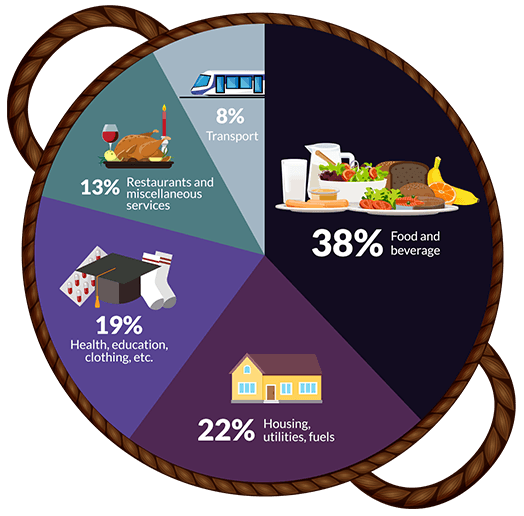
The government measures inflation through the consumer price index (CPI), which shows the change in the prices paid by consumers for a hypothetical basket of goods and services over time.
You know how you’d check your receipt after a trip to the supermarket to see if you paid more than you did during your last trip? The government does the same thing with the CPI on a monthly basis.
Some items like food and utilities weigh more than others because people generally spend more for them.
The government chooses a year to be the CPI’s base year and sets it equal to 100. Currently that year is 2012. For the sake of simplicity, let’s assume that there were 100 items in the CPI basket in 2012 and each of them cost P1.00. If today those items cost P1.50 each, then the CPI this year would stand at 150 to reflect the increase in prices.
If the CPI rises over a period of time, that’s called inflation. If it’s the opposite, then that’s deflation (we’ll delve into that later).
What do we mean when we say "inflation rate"? It tells you how quickly the CPI - or the prices of goods in the basket - went up during a particular period. So if the inflation rate was, say, 6.7% this month, then you can expect your P1,000 basket to cost P1,067 moving forward.
What goes into the Consumer Price Index

People have been stung. Even before inflation became widely reported, consumers had been complaining about rising prices online.
In the chart you’ll see how inflation-related conversations on Twitter began to grow early 2018, essentially following the inflation trend.
The bulk of the convos revolved around petroleum and rice. No surprise there: economists cited those two as the major drivers of inflation last year.
World oil prices had rocketed. Because the Philippines imports most of its oil needs, the country was gravely affected.
Oil is a major input linked to a lot of everyday things. It runs factories and fuels transportation so if its price soars so will the cost of finished goods and fares. It didn’t help that the government hiked taxes on petroleum products under the TRAIN Law. It was like “rubbing salt on one’s wounds,” as an economist has pointed out.
One other factor behind the surge in prices was the decline of the peso against the US dollar. It’s not just oil that the Philippines imports - the country imports a lot of goods as raw materials.
Because importers pay for their wares in dollars, they shell out more pesos if the dollar rate goes up. That added cost is also passed on to consumers.
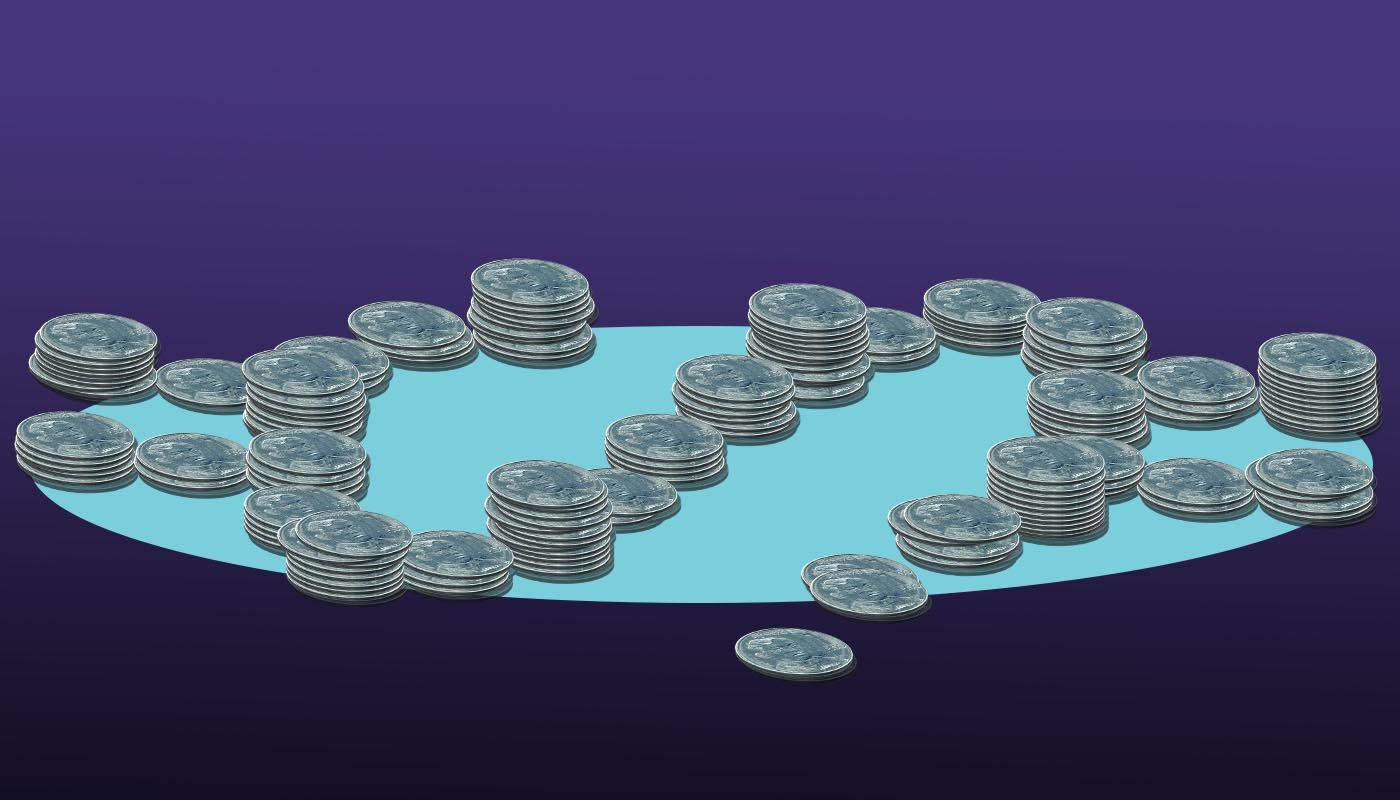
Several factors were to blame for the peso’s decline. One was the trade gap in which the country had more imports than exports. As we used more dollars to pay for imports, the uptick in demand for the foreign currency caused the peso’s value to drop, which in turn made imports more expensive. It’s like a chicken-and-egg situation that worsened inflation.
The peso’s value could have found support from exports (where there’s demand for Philippine goods, and thus for the local currency) but data shows exports shrunk in the past months.
Another reason was the capital flight where investors pulled their investments out of emerging markets and bought US securities instead. As they took their money out of the Philippines, they converted their pesos into dollars.
In the case of rice, tight supply drove prices up. With more buyers than rice available for sale, those buyers were willing to bid up the price of the staple food to get it before anyone else does.
A little bit of inflation is a good thing. When people’s incomes rise, their demand for goods also grows so prices naturally pick up over time. It’s a sign that the economy is expanding.
You don’t want a situation where there’s deflation and prices continuously fall - which means consumers are buying less and companies are making less profits.
That, in turn, may prompt the companies to cut workers’ salaries and even jobs, and the cycle continues.
That’s why the government has been working to keep inflation rate within an acceptable range.
The problem, though, is that inflation shot up in 2018. While it eased in November and December , thanks to the decrease in world oil prices and a better rice supply and peso, the average was still beyond the target of 2% to 4%.
When inflation speeds up and incomes don’t keep up, Filipinos’ living standards suffer.
The chart shows how wages have grown a lot slower than commodity prices.
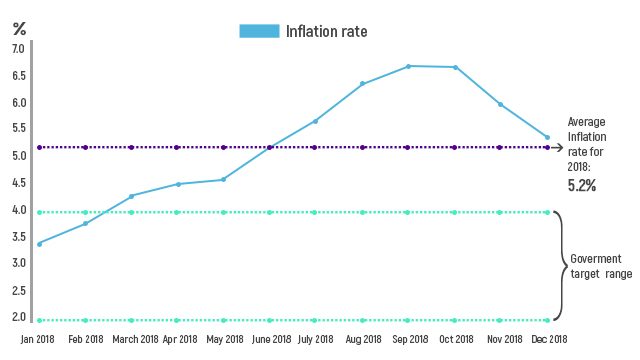
Sources: Philippine Statistics Authority, Bangko Sentral ng Pilipinas
A little bit of inflation is a good thing. When people’s incomes rise, their demand for goods also grows so prices naturally pick up over time. It’s a sign that the economy is expanding.
You don’t want a situation where there’s deflation and prices continuously fall - which means consumers are buying less and companies are making less profits.
That, in turn, may prompt the companies to cut workers’ salaries and even jobs, and the cycle continues.
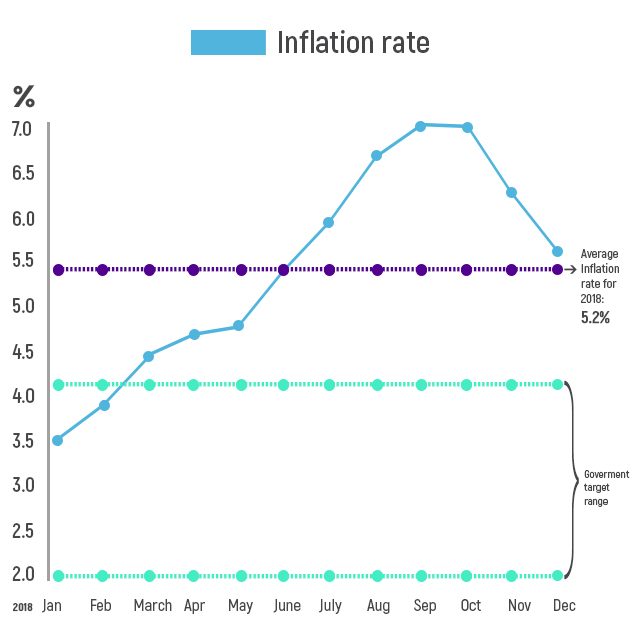
Sources: Philippine Statistics Authority, Bangko Sentral ng Pilipinas
The problem, though, is that inflation shot up in 2018. While it eased in November and December , thanks to the decrease in world oil prices and a better rice supply and peso, the average was still beyond the target of 2% to 4%.
When inflation speeds up and incomes don’t keep up, Filipinos’ living standards suffer.
The chart shows how wages have grown a lot slower than commodity prices.

The most effective way to protect yourself from inflation is to increase your ability to earn. Aim for a promotion or get a higher-paying job, or take on side jobs. Of course, if those aren’t possible, you can explore other means like investing in financial instruments.
If, say, the inflation rate stands at 3% and you keep your money in the bank with a deposit rate that’s lower than inflation, then you wouldn’t see any real return. That doesn’t mean you shouldn’t save; you need buffer funds. You can put money away in a high-interest savings account, and couple that with investments.
Invest in assets that earn an interest of 3% and above like stocks or mutual funds. That way your money can keep up with or even beat inflation.
Sources:
- Inflation searches from Google Trends
- Inflation rates and government target from the Philippine Statistics Authority and Bangko Sentral ng Pilipinas
- Consumer price index data from the Philippine Statistics Authority
- Data on inflation-related conversations from Twitter
- Dubai oil prices from the Fiscal Statistics Handbook, Department of Budget and Management
- Compensation growth rates from the Philippine Statistics Authority









